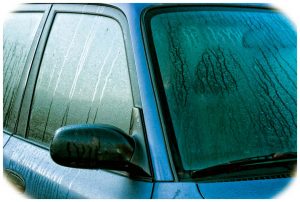Condensation is the process of liquid water vapor turning into a liquid. It occurs when warm, humid air comes into contact with cooler surfaces such as windows, dashboard, or interior walls of your car. This often happens when a car is parked for long periods of time in an area with high relative humidity. Because cars are small and enclosed spaces with limited circulation, this creates the perfect environment for condensation to form and accumulate.
The effects of condensation on your car

Causes of Condensation Inside Cars
Temperature changes – When temperatures change rapidly from hot to cold (or vice versa), moisture will form in your car due to condensation. This moisture can form on the windows, dashboard, and other interior surfaces.
Moisture in the air – High humidity can cause condensation inside your car more quickly. When the relative humidity is high (over 65%), water vapor will remain in the air longer and have a greater chance of settling on cooler surfaces such as your windows and dashboard.
Poor ventilation – Poor ventilation inside your car can also cause condensation. Without proper airflow, warm air will stay in the car longer and have a higher chance of coming into contact with cooler surfaces and forming condensation.
Water leaks – Moisture can also enter from outside sources, such as water leaks from damaged seals or gaskets or even rainwater entering through an open sunroof or window. To prevent this, it’s important to regularly check for any signs of water damage for any potential areas where moisture could enter your vehicle.
Signs of Condensation Inside Your Car

Dampness or wetness on the interior surfaces – Another sign of condensation is dampness or wetness on your dashboard, seats, and other interior surfaces. This is usually caused by high humidity and poor ventilation, which allows warm air to remain inside your car for longer periods of time.
Musty odor – If you notice a musty odor inside your car, this could be a sign that there is mold growth due to excessive moisture. It’s important to act quickly in this case, as mold can spread quickly and cause damage to the interior fabrics and upholstery in your car. Also read about Car AC Condenser Leak.
Preventing Condensation Inside Your Car
Use of desiccants – Desiccants are materials that absorb moisture from the air. This can help reduce the amount of moisture inside your car by absorbing any high humidity levels in the air, which would otherwise lead to condensation forming.
Regularly checking and fixing leaks – Checking for any potential water leaks regularly is an important step towards preventing condensation from entering your vehicle. It’s important to check around windows, sunroofs, doors, seals and gaskets for any signs of water damage or potential sources of water entering from outside.
Use of ventilation systems – A ventilation system can help keep the air inside your car fresh and reduce the humidity buildup inside. This is especially useful if you are parking in an area with high relative humidity or temperature changes.
Parking in a well-ventilated area – When possible, it’s best to park your car in a well-ventilated area such as a garage or covered parking lot. This will help reduce the amount of moisture buildup as there is more airflow and less chance for condensation to form on cooler surfaces.
Use of car covers – Car covers can be used to protect your car from moisture when it’s not being used. The cover will act as an additional layer between warm, humid air and cooler surfaces inside your vehicle which can help prevent condensation from forming.
Regular car cleaning – Cleaning your vehicle’s interior surfaces regularly can also help reduce the amount of moisture that accumulates inside. This includes wiping down windows, dashboard, seats and other interior surfaces to remove any dust or dirt which can contribute to higher humidity levels in enclosed areas like cars.
Conclusion
Temperature changes, moisture in the air, poor ventilation and water leaks cause condensation in cars. This can cause fogged-up windows, dampness or wetness on interior surfaces, and musty odors. To reduce and prevent condensation inside your car, it’s important to use desiccants, regularly check for leaks and fix them promptly, use ventilation systems, park in a well-ventilated area when possible, use of car covers to protect from moisture buildup when not in use, and clean the interior surfaces of your car regularly. All of these approaches can help reduce the amount of moisture inside your vehicle, which will help you enjoy a more comfortable ride while also reducing potential damage to the interior fabrics or upholstery caused by excessive humidity levels.


Add Comment